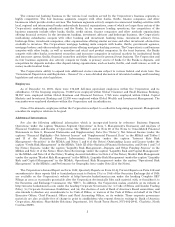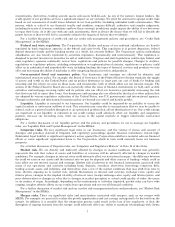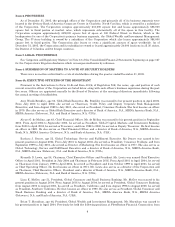Bank of America 2005 Annual Report Download - page 39
Download and view the complete annual report
Please find page 39 of the 2005 Bank of America annual report below. You can navigate through the pages in the report by either clicking on the pages listed below, or by using the keyword search tool below to find specific information within the annual report.Banks are organized as national banking associations, which are subject to regulation, supervision and examination by
the Office of the Comptroller of the Currency (the “Comptroller” or “OCC”), the Federal Deposit Insurance Corporation
(the “FDIC”), the Federal Reserve Board and other federal and state regulatory agencies. In addition to banking laws,
regulations and regulatory agencies, the Corporation and its subsidiaries and affiliates are subject to various other laws
and regulations and supervision and examination by other regulatory agencies, all of which directly or indirectly affect
the operations and management of the Corporation and its ability to make distributions to stockholders.
A financial holding company, and the companies under its control, are permitted to engage in activities considered
“financial in nature” as defined by the Gramm-Leach-Bliley Act and Federal Reserve Board interpretations (including,
without limitation, insurance and securities activities), and therefore may engage in a broader range of activities than
permitted for bank holding companies and their subsidiaries. A financial holding company may engage directly or
indirectly in activities considered financial in nature, either de novo or by acquisition, provided the financial holding
company gives the Federal Reserve Board after-the-fact notice of the new activities. The Gramm-Leach-Bliley Act also
permits national banks, such as the Banks, to engage in activities considered financial in nature through a financial
subsidiary, subject to certain conditions and limitations and with the approval of the Comptroller.
Bank holding companies (including bank holding companies that also are financial holding companies) also are
required to obtain the prior approval of the Federal Reserve Board before acquiring more than five percent of any class of
voting stock of any non-affiliated bank. Pursuant to the Riegle-Neal Interstate Banking and Branching Efficiency Act of
1994 (the “Interstate Banking and Branching Act”), a bank holding company may acquire banks located in states other
than its home state without regard to the permissibility of such acquisitions under state law, but subject to any state
requirement that the bank has been organized and operating for a minimum period of time, not to exceed five years, and
the requirement that the bank holding company, after the proposed acquisition, controls no more than 10 percent of the
total amount of deposits of insured depository institutions in the United States and no more than 30 percent or such
lesser or greater amount set by state law of such deposits in that state. Subject to certain restrictions, the Interstate
Banking and Branching Act also authorizes banks to merge across state lines to create interstate banks. The Interstate
Banking and Branching Act also permits a bank to open new branches in a state in which it does not already have
banking operations if such state enacts a law permitting de novo branching.
Changes in Regulations
Proposals to change the laws and regulations governing the banking industry are frequently introduced in Congress,
in the state legislatures and before the various bank regulatory agencies. The likelihood and timing of any proposals or
legislation and the impact they might have on the Corporation and its subsidiaries cannot be determined at this time.
Capital and Operational Requirements
The Federal Reserve Board, the Comptroller and the FDIC have issued substantially similar risk-based and
leverage capital guidelines applicable to United States banking organizations. In addition, these regulatory agencies
may from time to time require that a banking organization maintain capital above the minimum levels, whether because
of its financial condition or actual or anticipated growth. The Federal Reserve Board risk-based guidelines define a
three-tier capital framework. Tier 1 capital includes common shareholders’ equity, trust preferred securities, minority
interests and qualifying preferred stock, less goodwill and other adjustments. Tier 2 capital consists of preferred stock
not qualifying as Tier 1 capital, mandatory convertible debt, limited amounts of subordinated debt, other qualifying term
debt and the allowance for credit losses up to 1.25 percent of risk-weighted assets and other adjustments. Tier 3 capital
includes subordinated debt that is unsecured, fully paid, has an original maturity of at least two years, is not redeemable
before maturity without prior approval by the Federal Reserve Board and includes a lock-in clause precluding payment
of either interest or principal if the payment would cause the issuing bank’s risk-based capital ratio to fall or remain
below the required minimum. The sum of Tier 1 and Tier 2 capital less investments in unconsolidated subsidiaries
represents the Corporation’s qualifying total capital. Risk-based capital ratios are calculated by dividing Tier 1 and total
capital by risk-weighted assets. Assets and off-balance sheet exposures are assigned to one of four categories of risk-
weights, based primarily on relative credit risk. The minimum Tier 1 capital ratio is four percent and the minimum total
capital ratio is eight percent. The Corporation’s Tier 1 and total risk-based capital ratios under these guidelines at
December 31, 2005 were 8.25 percent and 11.08 percent, respectively. At December 31, 2005, the Corporation had no
subordinated debt that qualified as Tier 3 capital.
The leverage ratio is determined by dividing Tier 1 capital by adjusted average total assets. Although the stated
minimum ratio is 100 to 200 basis points above three percent, banking organizations are required to maintain a ratio of
at least five percent to be classified as well capitalized. The Corporation’s leverage ratio at December 31, 2005 was 5.91
percent. The Corporation meets its leverage ratio requirement.
The Federal Deposit Insurance Corporation Improvement Act of 1991 (“FDICIA”), among other things, identifies five
capital categories for insured depository institutions (well capitalized, adequately capitalized, undercapitalized,
3
























